1. Valeggio sul Mincio
The town lies on the border between the provinces of Verona and Mantua, and the territory of the municipality ranges from the moraine hills surrounding Lake Garda to the plains. Settlements in the vicinity of today’s town are attested since the Bronze Age (there were pile-dwelling villages in this place: remains were found in the 1950s), and also in the area there was in ancient times a large Celtic necropolis. The center began to take its present form in Lombard times, although the fortresses that now dot the landscape around the village (the Scaliger Castle of Valeggio and the Visconti dam at Borghetto sul Mincio, the picturesque hamlet of mills) date from the 14th century. Valeggio was in fact one of the most important garrisons of the Scaligeri, located on the border between the Veronese and Mantuan dominions: the village began to lose importance when, in 1405, it was subjugated by the Republic of Venice. Worth visiting, in addition to the historic center, the Castle (which, according to legend, is inhabited by the ghost of Andriolo da Parma, the castellan killed at the time when Valeggio came under Venice) and the charming hamlet of Borghetto, is also the Sigurtà Park, the vast garden of the villa of the same name, awarded in 2013 as Italy’s Most Beautiful Park.
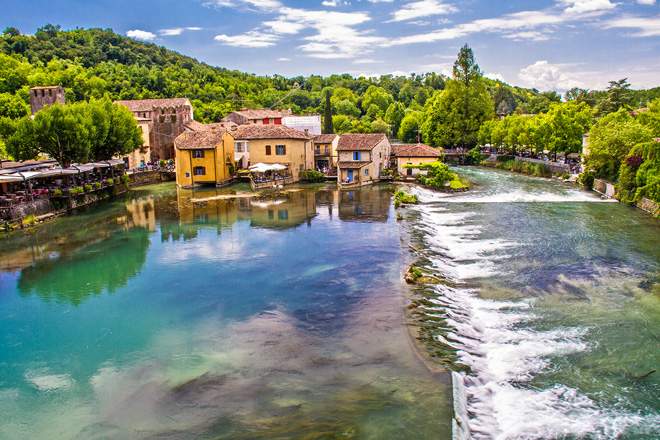 |
| Valeggio, the hamlet of Borghetto sul Mincio |
2. Montagnana
Not far from Padua, the town of Montagnana is world-renowned because it is surrounded by a perfectly preserved circle of walls, and that is one of the main reasons for visiting this town that lies on the Veneto plain near the Fratta River. The walls are fourteenth-century and date back to the period when Montagnana was a border town between the state of the Carraresi of Padua and that of the Scaligeri of Verona: between 6 1/2 and 8 meters high, they are interspersed with several towers that served military purposes but could also house warehouses. In the Middle Ages the mighty walls made Montagnana a virtually impregnable town, since the walls were built according to the most advanced technologies of the time: only in the Renaissance, with the invention of firearms, did the walls lose the importance they had had for centuries. Another evidence of the Montagnana carrarese is the Rocca degli Alberi, the imposing 14th-century fortress that rises in the western section of the walls. Worth visiting, inside the village (which retains an orderly Renaissance appearance when it underwent major transformations), is the Duomo, which houses, among other works, a Transfiguration by Veronese.
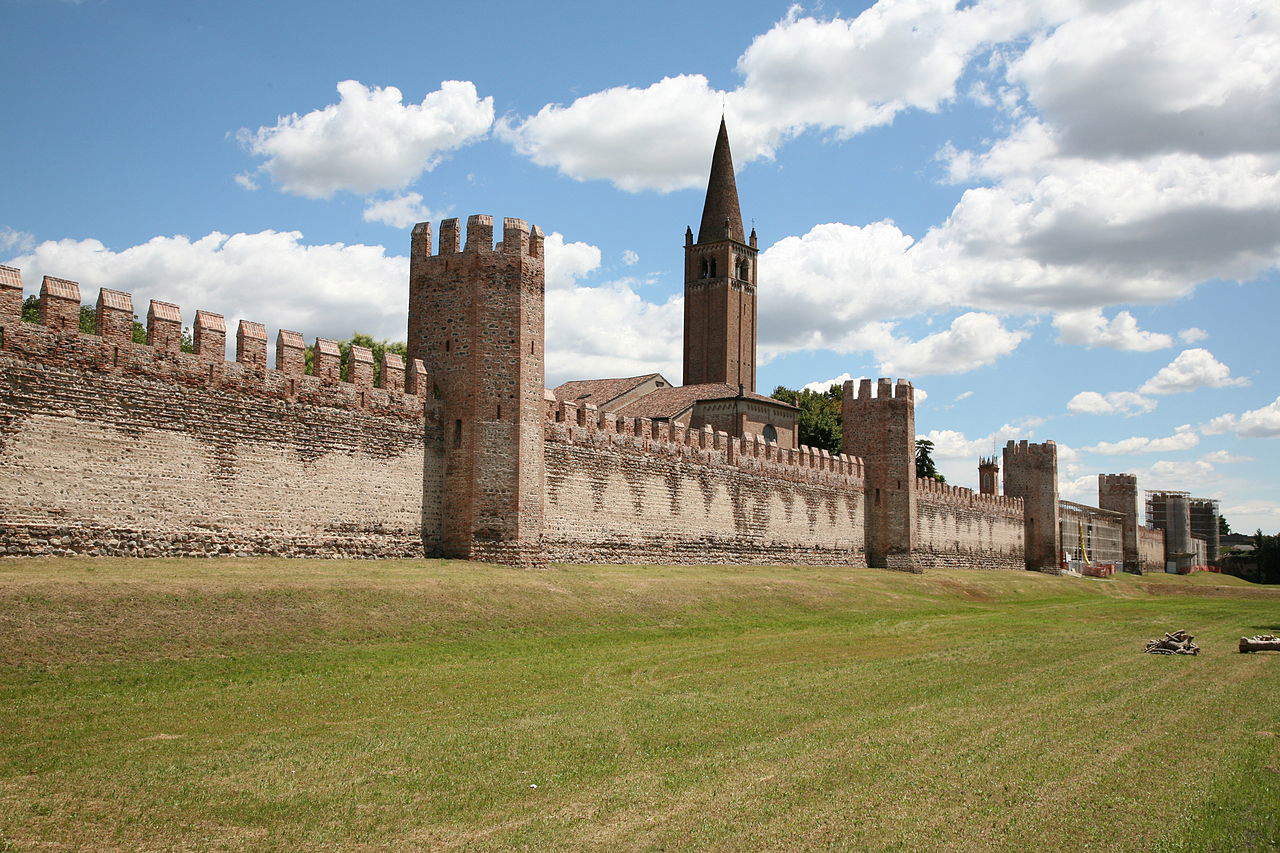 |
| The walls of Montagnana. Ph. Credit Hans Rosbach |
3. Monselice
It is one of the main centers of the Euganean Hills and derives its name from the Latin expression “mons silicis,” or “mons elicis”: in fact, on the hill under which Monselice stands were active until the 1970s quarries from which trachyte (“flint”) was extracted, but there are also flints, a species of plant that abounds in the woods of the area. Monselice experienced its season of greatest splendor between the 13th and 14th centuries, when it was one of the most important centers in the area and was subject to the rule of Ezzelino da Romano, who had the Fortress restored, now among the main monuments of the town, which presents itself to visitors among medieval and Renaissance buildings. Worth visiting, the Castle of Monselice, where the centuries-old stratification is evident since both the rooms of the Ezzelinian fortress modified in the 14th century by the Carraresi and the Renaissance rooms opened by the Marcello, the family of Venetian patricians who came into possession of the castle when Monselice passed under Venice, are preserved, well separated. And again, Monselice’s symbols include the Old Cathedral, a Romanesque-Gothic construction, and the Sanctuary of the Seven Little Churches, a masterpiece of architect Vincenzo Scamozzi, the most important of Palladio’s followers (the seven chapels in which it is composed contain works by Palma il Giovane).
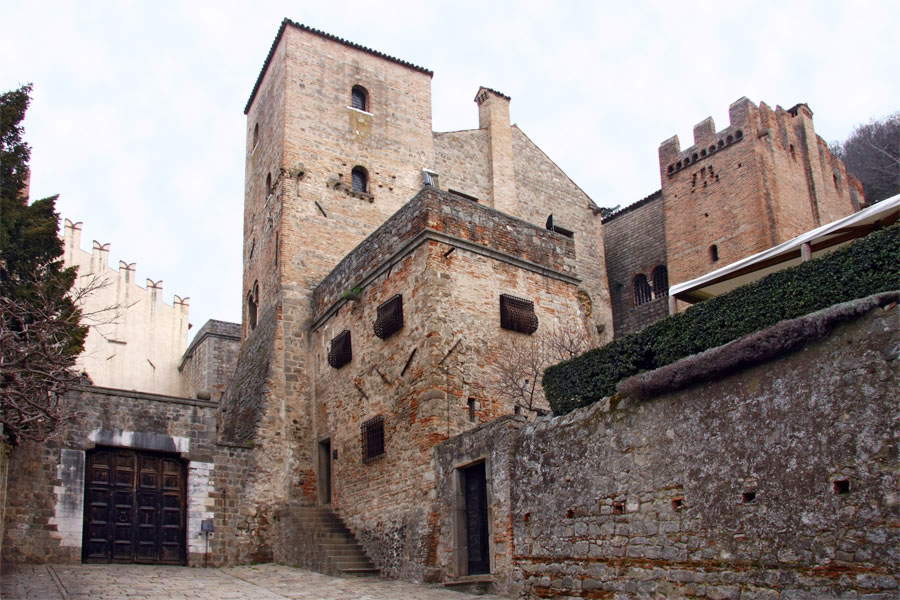 |
| The castle of Monselice. Ph. Credit Alessandro Vecchi |
4. Asolo
Asolo’s name evokes the Renaissance, the villeggiature of the Venetian nobles of the time, and the literature of Pietro Bembo, who set his Asolani, dialogues on love composed between 1497 and 1502, here. Asolo stands on a hill not far from Treviso, was in ancient times an outpost of the Romano, Scaligeri, and Carraresi families, and then passed, like the whole of Veneto, under Venice in the 15th century. It was with Venice that Asolo became an important center: the impetus came from Caterina Cornaro, who moved there at the end of the 15th century, creating a fertile artistic and literary environment (it is to her that the Asolani are dedicated). During the Renaissance, Asolo was enriched with works of art: not to be missed, inside the cathedral, is Lorenzo Lotto’sAssumption, also known as the Asolo Altarpiece, one of the great masterpieces of the Venetian Renaissance. Also worth seeing are the Palazzo della Ragione, dating back to the 15th century, the Asolo Castle, which was the residence of Caterina Cornaro (today it houses the Eleonora Duse theater: Gabriele D’Annunzio’s muse resided in Asolo for a long time), the so-called “Longobard house,” another important Renaissance building.
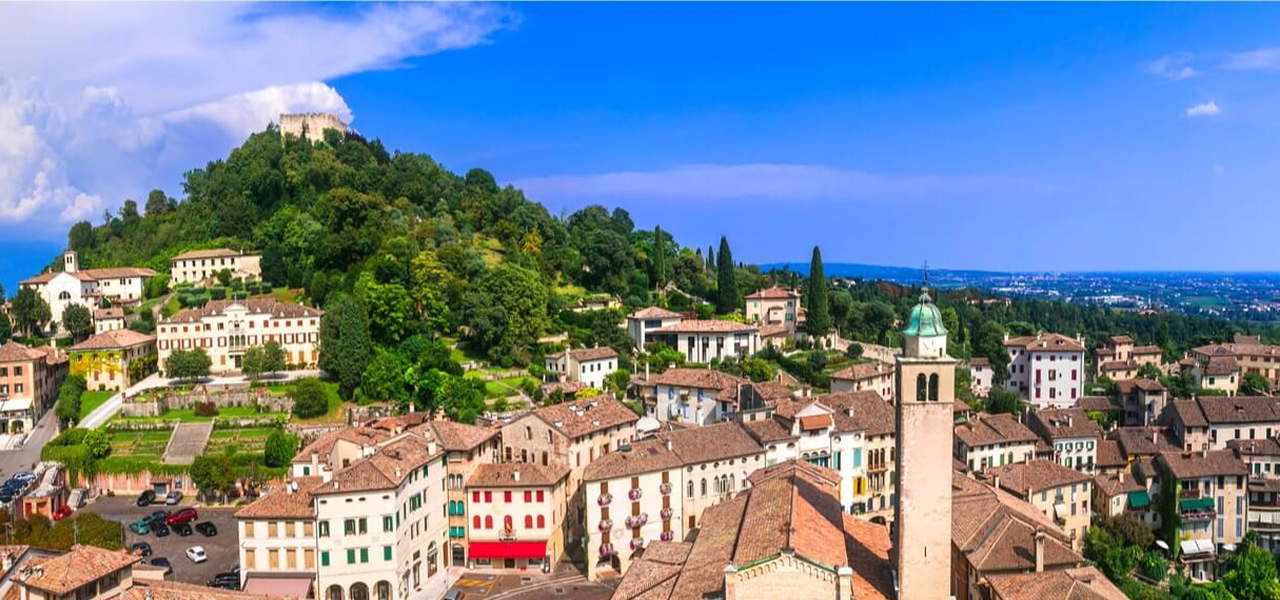 |
| View of Asolo. Ph. Credit Municipality of Asolo |
5. Stra
Stra is one of the main villages of the Riviera del Brenta, an idyllic place known for the splendid villas scattered throughout the territory. Stra, which stretches along the right bank of the Naviglio del Brenta canal, is no exception: it is here that one of the most beautiful Venetian villas, the Villa Pisani, now home to the Villa Pisani National Museum, is located. It was built starting in 1721 for the Venetian noble family, designed by Girolamo Frigimelica, and is famous because it houses one of the greatest masterpieces of the eighteenth century, theApotheosis of the Pisani Family by Giambattista Tiepolo. But there are several eighteenth-century Venetian works housed inside the sumptuous mansion (where, moreover, Napoleon also stayed). Another villa located in Stra is Villa Foscarini Rossi: it is older than Villa Pisani in that it was built in the seventeenth century but was remodeled in later centuries. It is named after the families who lived there (it was also the residence of Marco Foscarini, one of the last doges of Venice) and now houses the Rossimoda Museum of Footwear (Stra is also famous for its shoe factories).
 |
| Stra, Villa Pisani. Ph. Credit Didier Descouens |
6. Cison di Valmarino
Located in an area midway between the plains and the Belluno Pre-Alps, Cison di Valmarino, in the province of Treviso, is an ancient medieval village that began to develop beginning in the Longobard period, and was later an important center of the lords of the Marca trevigiana. It lost its importance when it became part of the Republic of Venice, and even today the village largely retains its medieval and Renaissance buildings. Worth visiting are the cathedral, of very ancient origins (it is documented as early as 1170), but which presents itself in its eighteenth-century appearance, and Castelbrando, in ancient times a fortress inhabited by the Brandolini, a Forlì family of condottieri who, once the period of wars was over, transformed the castle into a splendid stately residence (the castle was inhabited by the Brandolini until the 1950s: today it houses a hotel).
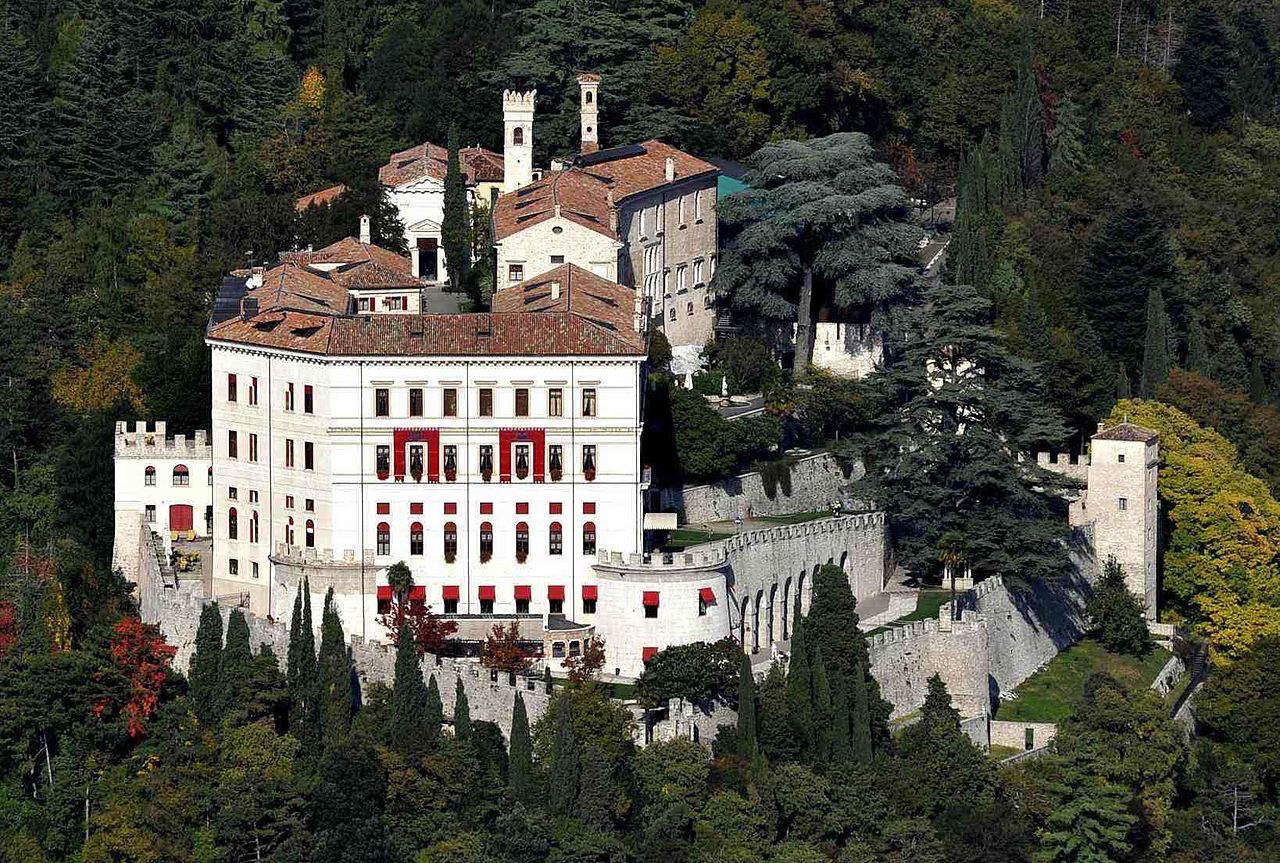 |
| Cison di Vlmarino, Castelbrando |
7. Villafranca di Verona
Villafranca is not only the town that hosts the Verona airport, it is also a village rich in history. And historically it is most famous for the “Peace of Villafranca,” the event from which began the end of the Second War of Independence: the room in which it was signed is located in Palazzo Bottagisio, since then known as the “house of the Treaty” and now home to the Museo del Risorgimento, which collects various material from the period. Inside the village are the Duomo, which houses canvases by great artists of the 16th-century Veronese school (such as Felice and Domenico Brusasorzi), the churches of San Rocco and Disciplina, rich in works from the 15th to the 18th century, and the famous Scaliger Castle, which closes the town on one of its sides and where Shakespeare set some moments of his Romeo and Juliet. Having fallen into disrepair over the centuries (it was also a prison in the nineteenth century), it was restored in the last century and today is most famous in the world of music because its vast court hosts a major rock music festival every year that has seen the biggest international stars take turns on stage, from Deep Purple to Soundgarden, Arctic Monkeys to Rammstein.
 |
| Villafranca di Verona, the Scaliger Castle |
8. Follina
On the extreme foothills of the Belluno Prealps, in the territory of the Alta Marca Trevigiana, lies the village of Follina: the area is known for prehistoric settlements, but the village began to develop in the 12th century when Cistercian monks arrived in Follina and erected the Abbey of Santa Maria, also known as the Abbey of Sanavalle. Much of the history of the village is linked to the monastery: the period of maximum development was the 13th century (when the cloister, dating from 1268, was built, while the basilica is from the early 14th century), and when the Venetian Republic ceded it to private individuals (since the monastery was suppressed), the building was radically transformed, to the point of being defaced. The damage continued in the Napoleonic era and especially during World War I (restoration followed). Inside, there are works from various periods, including a 16th-century fresco by the painter Francesco da Milano, who was active for a long time in these areas.
 |
| The cloister of the abbey of Follina |
9. Castelfranco Veneto
The city of Castelfranco Veneto, of more than thirty thousand inhabitants, is a modern center of industry and commerce, but the historic center enclosed by its sumptuous and recognizable walls and surrounded by a moat, is a hamlet that retains intact its ancient appearance, taking us back to the Middle Ages when Castelfranco’s importance was due to the fact that it was a “franca” or tax-free town. The name of the town is inextricably linked to that of its most illustrious historical figure, Giorgione, one of the great masters of the Venetian Renaissance. His works can be found in the town: the celebrated Castelfranco Altarpiece, an undisputed masterpiece of Italian art history, which is located in the Cathedral of Santa Maria Assunta and Liberale, and the Frieze of the Liberal and Mechanical Arts, which decorates one of the rooms of the building known as Casa Giorgione, now a visitable museum, which in 2010 was the site of the major monographic exhibition dedicated to the painter. It was not actually the house where he lived (although a seventeenth-century source indicates it as such), but it is more likely to be a residence where the artist found himself working.
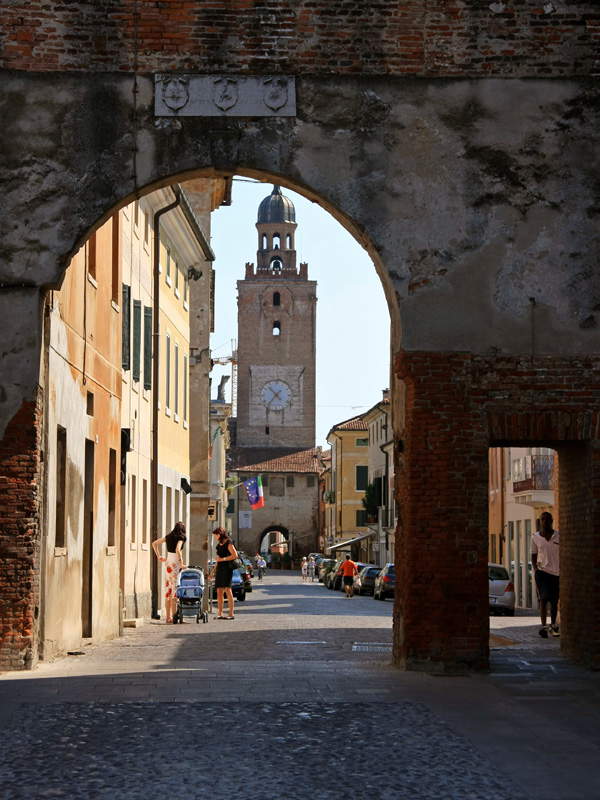 |
| Castelfranco Veneto. Ph. Credit Alessandro Vecchi |
10. Bardolino
Bardolino is one of the most popular resorts on the Veronese shore of Lake Garda, and is known for its wines but also for the amenity of the village, which is rich in historical evidence that reflects its importance: it was first a religious hundred dependent on the abbey of San Colombano di Bobbio but endowed with a certain autonomy, then it became a free commune, and finally passed first to Verona and then to Venice. Bardolino is home to some of the most interesting buildings of worship in the area: the abbey church of San Zeno, one of the main churches from the Carolingian period that have been preserved in Italy (there are still ancient paintings and testimonies), and the chiessa of San Severo, which stands out for its high bell tower and Romanesque appearance that is still well preserved (but there are also frescoes that date back to remote times: some paintings date back to the 12th century). Bardolino then experienced a new “renaissance” in the 19th century, when it became a resort town and was surrounded by magnificent villas. And even today the town maintains its tourist vocation.
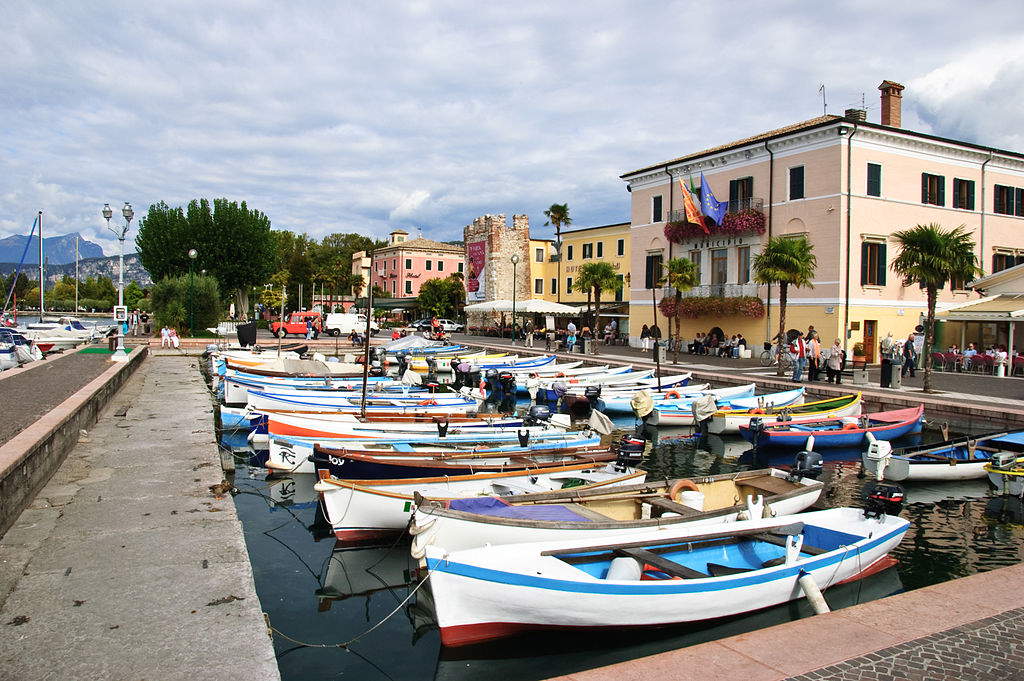 |
| The small port of Bardolino. Ph. Credit Richard Gillin |
 |
| Ten villages to visit in Veneto |
Warning: the translation into English of the original Italian article was created using automatic tools. We undertake to review all articles, but we do not guarantee the total absence of inaccuracies in the translation due to the program. You can find the original by clicking on the ITA button. If you find any mistake,please contact us.